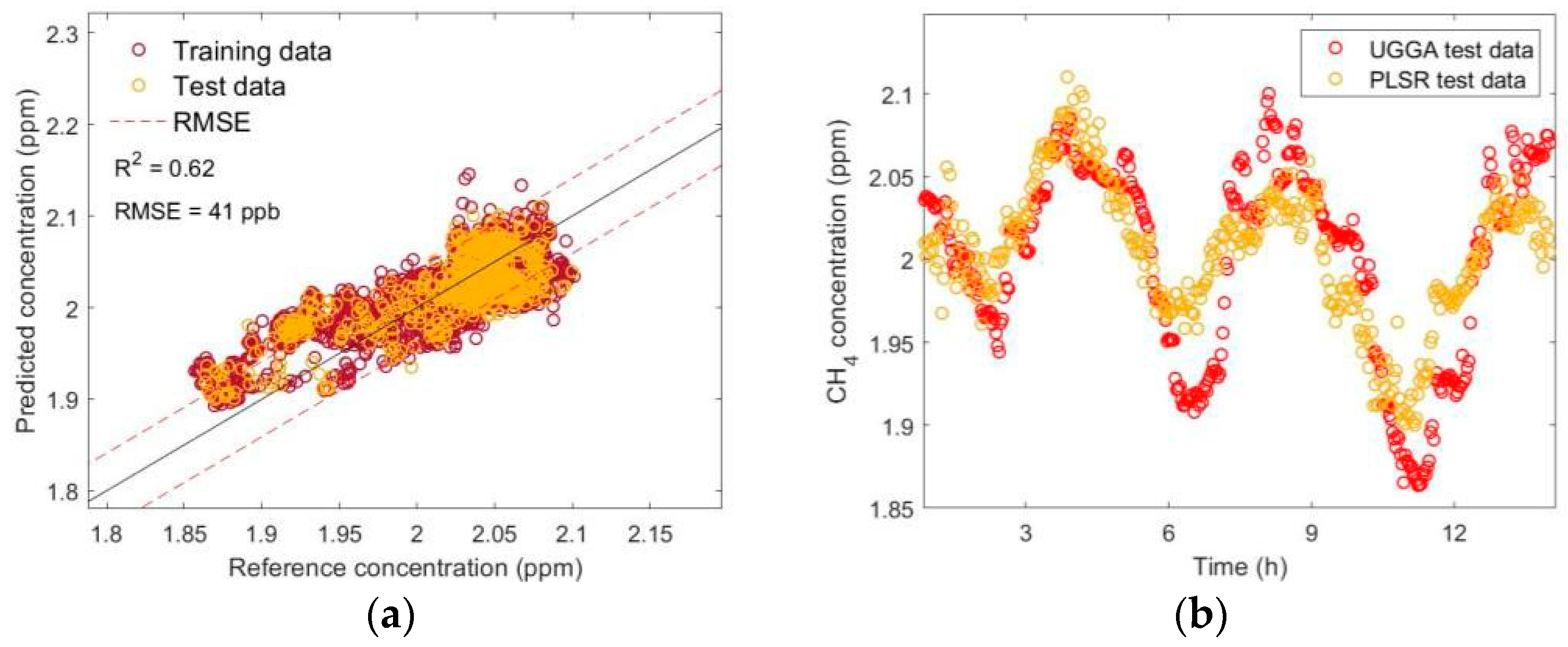Efficient Methane Monitoring with Low-Cost Chemical Sensors and Machine Learning †
Abstract
:1. Introduction
2. Materials and Methods
3. Discussion
Author Contributions
Funding
Institutional Review Board Statement
Informed Consent Statement
Data Availability Statement
Conflicts of Interest
References
- Myhre, G.; Shindell, D.; Bréon, F.-M.; Collins, W.; Fuglestvedt, J.; Huang, J.; Koch, D.; Lamarque, J.-F.; Lee, D.; Mendoza, B.; et al. Anthropogenic and Natural Radiative Forcing. In Climate Change 2013: The Physical Science Basis. Contribution of Working Group I to the Fifth Assessment Report of the Intergovernmental Panel on Climate Change; Stocker, T., Qin, D., Plattner, G.-K., Tignor, M., Allen, S., Boschung, J., Nauels, A., Xia, Y., Bex, V., Midgley, P., Eds.; Cambridge University Press: Cambridge, UK; New York, NY, USA, 2013; pp. 659–740. [Google Scholar]
- Saunois, M.; Stavert, A.R.; Poulter, B.; Bousquet, P.; Canadell, J.G.; Jackson, R.B.; Raymond, P.A.; Dlugokencky, E.J.; Houweling, S.; Patra, P.K.; et al. The Global Methane Budget 2000–2017. Earth Syst. Sci. Data 2020, 12, 1561–1623. [Google Scholar] [CrossRef]
- Bastviken, D.; Wilk, J.; Duc, N.T.; Gålfalk, M.; Karlson, M.; Neset, T.-S.; Opach, T.; Enrich-Prast, A.; Sundgren, I. Critical method needs in measuring greenhouse gas fluxes. Environ. Res. Lett. 2022, 17, 104009. [Google Scholar] [CrossRef]

Disclaimer/Publisher’s Note: The statements, opinions and data contained in all publications are solely those of the individual author(s) and contributor(s) and not of MDPI and/or the editor(s). MDPI and/or the editor(s) disclaim responsibility for any injury to people or property resulting from any ideas, methods, instructions or products referred to in the content. |
© 2024 by the authors. Licensee MDPI, Basel, Switzerland. This article is an open access article distributed under the terms and conditions of the Creative Commons Attribution (CC BY) license (https://creativecommons.org/licenses/by/4.0/).
Share and Cite
Domènech-Gil, G.; Duc, N.T.; Wikner, J.J.; Eriksson, J.; Puglisi, D.; Bastviken, D. Efficient Methane Monitoring with Low-Cost Chemical Sensors and Machine Learning. Proceedings 2024, 97, 79. https://doi.org/10.3390/proceedings2024097079
Domènech-Gil G, Duc NT, Wikner JJ, Eriksson J, Puglisi D, Bastviken D. Efficient Methane Monitoring with Low-Cost Chemical Sensors and Machine Learning. Proceedings. 2024; 97(1):79. https://doi.org/10.3390/proceedings2024097079
Chicago/Turabian StyleDomènech-Gil, Guillem, Nguyen Thanh Duc, J. Jacob Wikner, Jens Eriksson, Donatella Puglisi, and David Bastviken. 2024. "Efficient Methane Monitoring with Low-Cost Chemical Sensors and Machine Learning" Proceedings 97, no. 1: 79. https://doi.org/10.3390/proceedings2024097079





